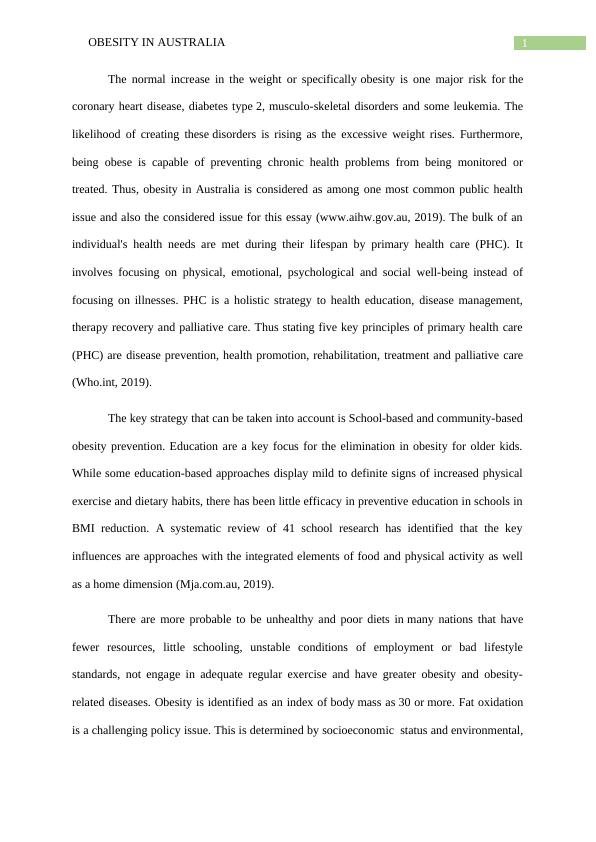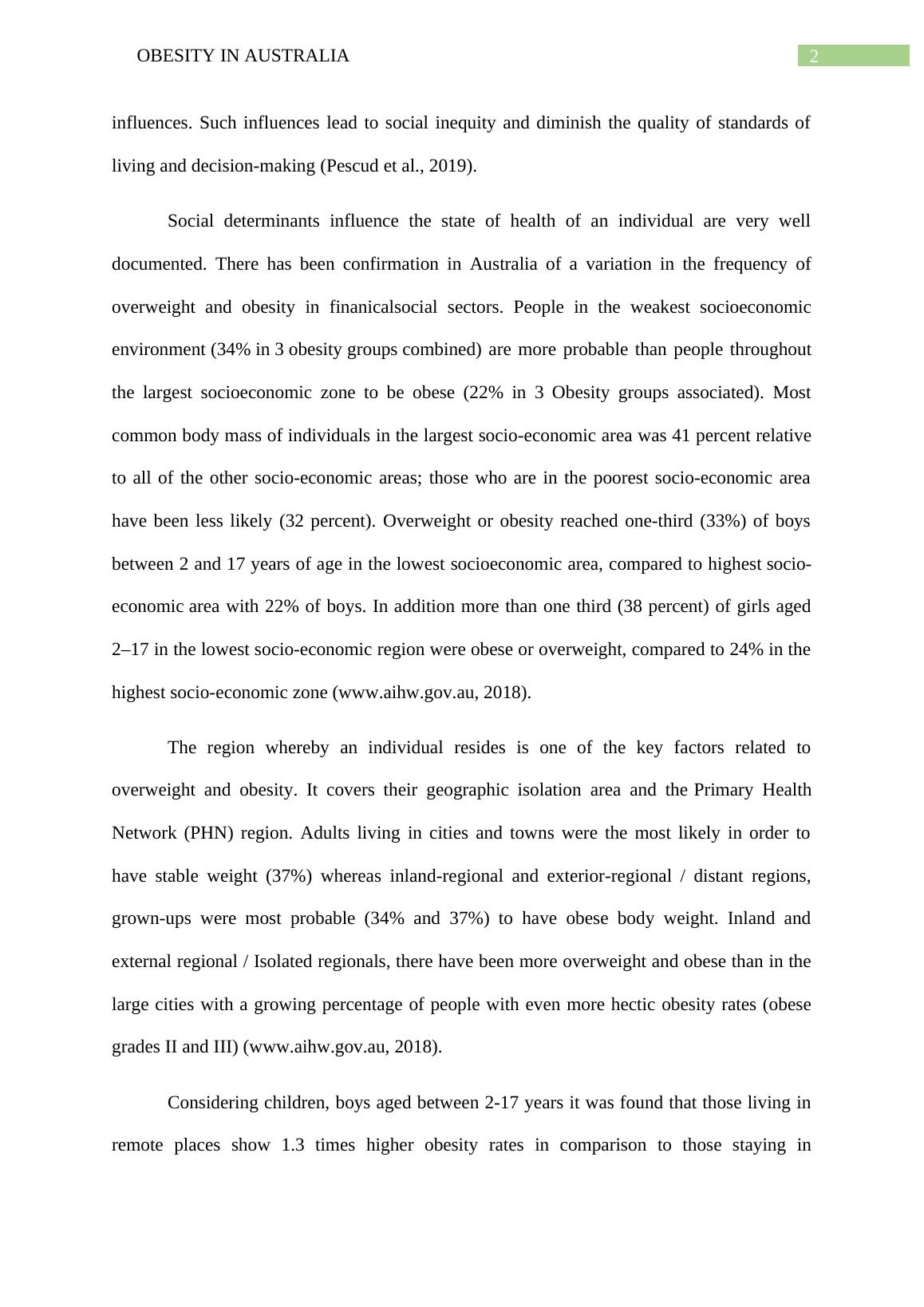THE OBESITY IN AUSTRALIA
Added on 2022-09-08
6 Pages1521 Words40 Views
Running head: OBESITY IN AUSTRALIA
Obesity as Chronic Health issues in Australia
Name of the Student:
Name of the University:
Author Note:
Obesity as Chronic Health issues in Australia
Name of the Student:
Name of the University:
Author Note:

1OBESITY IN AUSTRALIA
The normal increase in the weight or specifically obesity is one major risk for the
coronary heart disease, diabetes type 2, musculo-skeletal disorders and some leukemia. The
likelihood of creating these disorders is rising as the excessive weight rises. Furthermore,
being obese is capable of preventing chronic health problems from being monitored or
treated. Thus, obesity in Australia is considered as among one most common public health
issue and also the considered issue for this essay (www.aihw.gov.au, 2019). The bulk of an
individual's health needs are met during their lifespan by primary health care (PHC). It
involves focusing on physical, emotional, psychological and social well-being instead of
focusing on illnesses. PHC is a holistic strategy to health education, disease management,
therapy recovery and palliative care. Thus stating five key principles of primary health care
(PHC) are disease prevention, health promotion, rehabilitation, treatment and palliative care
(Who.int, 2019).
The key strategy that can be taken into account is School-based and community-based
obesity prevention. Education are a key focus for the elimination in obesity for older kids.
While some education-based approaches display mild to definite signs of increased physical
exercise and dietary habits, there has been little efficacy in preventive education in schools in
BMI reduction. A systematic review of 41 school research has identified that the key
influences are approaches with the integrated elements of food and physical activity as well
as a home dimension (Mja.com.au, 2019).
There are more probable to be unhealthy and poor diets in many nations that have
fewer resources, little schooling, unstable conditions of employment or bad lifestyle
standards, not engage in adequate regular exercise and have greater obesity and obesity-
related diseases. Obesity is identified as an index of body mass as 30 or more. Fat oxidation
is a challenging policy issue. This is determined by socioeconomic status and environmental,
The normal increase in the weight or specifically obesity is one major risk for the
coronary heart disease, diabetes type 2, musculo-skeletal disorders and some leukemia. The
likelihood of creating these disorders is rising as the excessive weight rises. Furthermore,
being obese is capable of preventing chronic health problems from being monitored or
treated. Thus, obesity in Australia is considered as among one most common public health
issue and also the considered issue for this essay (www.aihw.gov.au, 2019). The bulk of an
individual's health needs are met during their lifespan by primary health care (PHC). It
involves focusing on physical, emotional, psychological and social well-being instead of
focusing on illnesses. PHC is a holistic strategy to health education, disease management,
therapy recovery and palliative care. Thus stating five key principles of primary health care
(PHC) are disease prevention, health promotion, rehabilitation, treatment and palliative care
(Who.int, 2019).
The key strategy that can be taken into account is School-based and community-based
obesity prevention. Education are a key focus for the elimination in obesity for older kids.
While some education-based approaches display mild to definite signs of increased physical
exercise and dietary habits, there has been little efficacy in preventive education in schools in
BMI reduction. A systematic review of 41 school research has identified that the key
influences are approaches with the integrated elements of food and physical activity as well
as a home dimension (Mja.com.au, 2019).
There are more probable to be unhealthy and poor diets in many nations that have
fewer resources, little schooling, unstable conditions of employment or bad lifestyle
standards, not engage in adequate regular exercise and have greater obesity and obesity-
related diseases. Obesity is identified as an index of body mass as 30 or more. Fat oxidation
is a challenging policy issue. This is determined by socioeconomic status and environmental,

2OBESITY IN AUSTRALIA
influences. Such influences lead to social inequity and diminish the quality of standards of
living and decision-making (Pescud et al., 2019).
Social determinants influence the state of health of an individual are very well
documented. There has been confirmation in Australia of a variation in the frequency of
overweight and obesity in finanicalsocial sectors. People in the weakest socioeconomic
environment (34% in 3 obesity groups combined) are more probable than people throughout
the largest socioeconomic zone to be obese (22% in 3 Obesity groups associated). Most
common body mass of individuals in the largest socio-economic area was 41 percent relative
to all of the other socio-economic areas; those who are in the poorest socio-economic area
have been less likely (32 percent). Overweight or obesity reached one-third (33%) of boys
between 2 and 17 years of age in the lowest socioeconomic area, compared to highest socio-
economic area with 22% of boys. In addition more than one third (38 percent) of girls aged
2–17 in the lowest socio-economic region were obese or overweight, compared to 24% in the
highest socio-economic zone (www.aihw.gov.au, 2018).
The region whereby an individual resides is one of the key factors related to
overweight and obesity. It covers their geographic isolation area and the Primary Health
Network (PHN) region. Adults living in cities and towns were the most likely in order to
have stable weight (37%) whereas inland-regional and exterior-regional / distant regions,
grown-ups were most probable (34% and 37%) to have obese body weight. Inland and
external regional / Isolated regionals, there have been more overweight and obese than in the
large cities with a growing percentage of people with even more hectic obesity rates (obese
grades II and III) (www.aihw.gov.au, 2018).
Considering children, boys aged between 2-17 years it was found that those living in
remote places show 1.3 times higher obesity rates in comparison to those staying in
influences. Such influences lead to social inequity and diminish the quality of standards of
living and decision-making (Pescud et al., 2019).
Social determinants influence the state of health of an individual are very well
documented. There has been confirmation in Australia of a variation in the frequency of
overweight and obesity in finanicalsocial sectors. People in the weakest socioeconomic
environment (34% in 3 obesity groups combined) are more probable than people throughout
the largest socioeconomic zone to be obese (22% in 3 Obesity groups associated). Most
common body mass of individuals in the largest socio-economic area was 41 percent relative
to all of the other socio-economic areas; those who are in the poorest socio-economic area
have been less likely (32 percent). Overweight or obesity reached one-third (33%) of boys
between 2 and 17 years of age in the lowest socioeconomic area, compared to highest socio-
economic area with 22% of boys. In addition more than one third (38 percent) of girls aged
2–17 in the lowest socio-economic region were obese or overweight, compared to 24% in the
highest socio-economic zone (www.aihw.gov.au, 2018).
The region whereby an individual resides is one of the key factors related to
overweight and obesity. It covers their geographic isolation area and the Primary Health
Network (PHN) region. Adults living in cities and towns were the most likely in order to
have stable weight (37%) whereas inland-regional and exterior-regional / distant regions,
grown-ups were most probable (34% and 37%) to have obese body weight. Inland and
external regional / Isolated regionals, there have been more overweight and obese than in the
large cities with a growing percentage of people with even more hectic obesity rates (obese
grades II and III) (www.aihw.gov.au, 2018).
Considering children, boys aged between 2-17 years it was found that those living in
remote places show 1.3 times higher obesity rates in comparison to those staying in

End of preview
Want to access all the pages? Upload your documents or become a member.
Related Documents
ASSIGNMENTS ON OBESITY DISEASElg...
|13
|3631
|22
Chronic Conditions in Australialg...
|10
|2382
|454
Obesity among low socio-economic groupslg...
|16
|3802
|81
Public Health Promotion: Teenagers and Young Adults from Middle Class Indigenous Population Suffering from Obesitylg...
|17
|2901
|112
Obesity Prevention Assessment 2022lg...
|18
|3946
|42
Disease Prevention and Management Assignment 2022lg...
|16
|4469
|19
